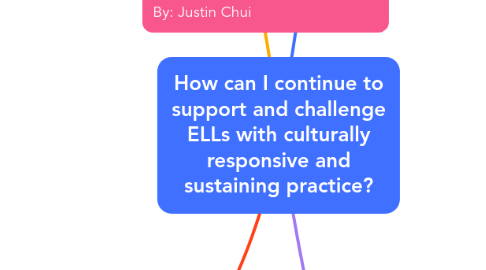
1. Supports and Strategies
1.1. Scaffolding
1.1.1. Sentence Stems
1.1.2. Model Think Alouds
1.1.3. Visual supports
1.1.4. New activities and skills are modeled
1.1.5. Alternative ways of understanding information
1.1.5.1. Videos, Audiobooks, Podcasts
1.2. Connections and Accessing prior knowledge
1.2.1. Discussions
1.2.2. Read Alouds
1.2.3. Familiar and past experiences
1.3. Visual Thinking
1.3.1. Project Zero's Visual Thinking Routines
2. Supporting and Challenging ELLs
2.1. Want students to have self confidence and growth mindset
2.1.1. "I belong here, I can succeed at this, My ability and competences grow with my effort, This work has value for me"
2.2. Support ELLs to receive equitable opportunities
2.2.1. Examine policies and procedures to ensure opportunities are available
2.3. Encourage academic rigor and challenge ELLs
2.3.1. Set high expectations with scaffolds
2.3.2. Interdisciplinary and Collaborative project based learning units
2.3.2.1. Explicitly teach skills to be supported and learn through these modalities
2.3.3. Engage in social justice and anti-racist work
2.3.4. Engage in regular oral and written language practice in content instruction
2.3.5. Engage in grade level content with modified language levels
2.3.5.1. Content Objectives
2.3.5.2. Language Objectives
2.3.6. Building an academic mindset
2.3.6.1. Acknowledge failure as a normal and temporary part of the learning process
2.3.6.2. Explicitly teach and identify the academic mindset
2.3.6.2.1. Why is it important
2.3.6.3. Reflections
2.3.6.4. Foster academic language use
3. Cultural Differences
3.1. Translanguaging
3.1.1. Dynamic Bilingualism acknowledges that linguistic features of bilinguals form a unitary linguistic system that dynamically interacts with each other
3.1.2. Includes code switching, language interdependence, linguistic hybridity
3.1.2.1. These are from a monolingual perspective - translanguaging doesn't treat bilinguals as 2 monolinguals in 1 brain
3.1.2.2. Translanguaging is a dynamic system that has more tools, resources, and flexibility to express and communicate
3.1.3. Demonstrates to students that there isn't only 1 correct way to language
3.1.4. Students may be in all types of bilingual language situations at home
3.2. Creating a culturally sustaining classroom
3.2.1. Increase relatability and connections through culturally diverse resources in the classroom
3.2.2. Cultural pluralism
3.3. Acknowledging, preserving and supporting student's cultural identities
3.3.1. Understand their past experiences and home life
3.3.2. Cultural norms and priorities
3.3.3. Open mindedness
4. Relationship Building
4.1. Families
4.1.1. Goals
4.1.1.1. Make families feel connected and part of the school community
4.1.1.2. Families play a large role in student success and achievement
4.1.1.2.1. Show and model how they can support
4.1.2. Barriers
4.1.2.1. Language
4.1.2.1.1. Support with translation tools and resources
4.1.2.1.2. Affirm and empower cultural language and identity
4.1.2.2. Resources
4.1.2.2.1. Time
4.1.2.2.2. Childcare
4.1.2.2.3. Transportation
4.1.2.3. Cultural Differences
4.1.2.3.1. Role of the parent in education
4.1.2.3.2. Educational Values
4.1.2.3.3. Good intentions but unsure on how to support
4.2. Students
4.2.1. Get to know students
4.2.2. Relationship building activities and icebreakers
4.2.3. Regular group work
4.2.4. Representation in the classroom and in resources
4.2.5. Choice and autonomy
4.2.6. Community and Interests
